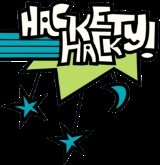
Hackety Hack
Encyclopedia
Hackety Hack is an open source
application that teaches individuals how to create software. It combines an IDE
with an extensive Lessons system. The cross-platform
desktop application also has integration with the website, where "Hackers" can share what they've learned, ask questions, and submit feedback.
in order to solve The Little Coder's Predicament; that learning modern software development is complicated, and difficult. Why eventually developed The Bylaws of Hackety in the Hackety Manifesto which lay down the guidelines for the project.
Why enlisted the help of a group of 25 parents and their children to get early feedback, who he referred to as "50 of my closest friends". The earliest iterations of Hackety Hack were based on an embedded Gecko browser, but this eventually transformed into the Shoes GUI toolkit
.
, the Ruby community was able to revive them. A small team kept working, releasing v0.9 on Christmas of 2009, and finally 1.0 on Christmas of 2010. The development team is planning on accelerating the release schedule, with new versions being released roughly monthly.
. There are two major differences: Both of these projects use a graphical programming language based on the concept of "blocks," but Hackety Hack teaches Ruby. Both Scratch and Alice are university projects out of MIT and CMU, respectively, and Hackety Hack has no university affiliation.
Open-source software
Open-source software is computer software that is available in source code form: the source code and certain other rights normally reserved for copyright holders are provided under a software license that permits users to study, change, improve and at times also to distribute the software.Open...
application that teaches individuals how to create software. It combines an IDE
Integrated development environment
An integrated development environment is a software application that provides comprehensive facilities to computer programmers for software development...
with an extensive Lessons system. The cross-platform
Cross-platform
In computing, cross-platform, or multi-platform, is an attribute conferred to computer software or computing methods and concepts that are implemented and inter-operate on multiple computer platforms...
desktop application also has integration with the website, where "Hackers" can share what they've learned, ask questions, and submit feedback.
History
Hackety Hack was originally created by whyWhy the lucky stiff
why the lucky stiff is the persona formerly used by an anonymous and prolific writer, cartoonist, musician, artist, and computer programmer notable for his work with the Ruby programming language...
in order to solve The Little Coder's Predicament; that learning modern software development is complicated, and difficult. Why eventually developed The Bylaws of Hackety in the Hackety Manifesto which lay down the guidelines for the project.
Why enlisted the help of a group of 25 parents and their children to get early feedback, who he referred to as "50 of my closest friends". The earliest iterations of Hackety Hack were based on an embedded Gecko browser, but this eventually transformed into the Shoes GUI toolkit
Shoes (GUI toolkit)
Shoes is a GUI toolkit based on the Ruby Programming Language. It was originally developed by why the lucky stiff, and others are carrying on with it after his disappearance. Shoes runs on Microsoft Windows, Mac OS X and Linux , using the underlying technologies of Cairo and Pango.Shoes' philosophy...
.
Post-Why development
Why intended to release Hackety Hack 1.0 at the Art and Code Symposium. In his talk, he showed off a build that's known as "version 0.L," with promises of a 1.0 soon to follow. This never came to pass, as Why mysteriously disappeared in August of 2009, deleting his projects. Because they were stored in gitGit (software)
Git is a distributed revision control system with an emphasis on speed. Git was initially designed and developed by Linus Torvalds for Linux kernel development. Every Git working directory is a full-fledged repository with complete history and full revision tracking capabilities, not dependent on...
, the Ruby community was able to revive them. A small team kept working, releasing v0.9 on Christmas of 2009, and finally 1.0 on Christmas of 2010. The development team is planning on accelerating the release schedule, with new versions being released roughly monthly.
Ruby Summer of Code 2010
Hackety Hack was chosen as a project for the Ruby Summer of Code in 2010. Fela Winkelmolen was the student chosen to work on the project. Chris Redinger, Jeff Casimir, Sarah Mei, and Steve Klabnik are mentoring.Comparison with other educational software
The two largest similar projects are Scratch and AliceAlice (software)
Alice is a freeware object-oriented educational programming language with an integrated development environment . Later versions are implemented in Java. Alice uses a drag and drop environment to create computer animations using 3D models...
. There are two major differences: Both of these projects use a graphical programming language based on the concept of "blocks," but Hackety Hack teaches Ruby. Both Scratch and Alice are university projects out of MIT and CMU, respectively, and Hackety Hack has no university affiliation.

